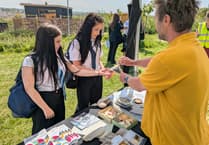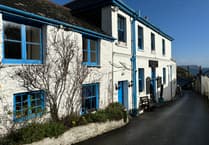History buffs have been given the opportunity to learn about the fascinating finds discovered during an archaeological dig in Newquay.
Sean Taylor, the principle archaeologist at the Cornwall Archaeological Unit staged a talk titled excavating the site near Trevemper Bridge during spring 2023, which was hosted by Newquay Old Cornwall Society at the WI Hall in Crantock Street.
A series of ancient dwellings were discovered at the site where a new housing development is being built.
A specialist team from the Cornwall Archaeological Unit uncovered three Bronze Age roundhouses, a Roman-period settlement consisting of an oval house, a large processing area, thought to be used for cereals, and two rectangular buildings, probably former barns, at the site in Trevemper Road.
Sean stated it was rare that so much was found from different periods in such a small area.
Experts believes it is starting to look like the area around Trevemper and along the Gannel was a “very important” and densely populated area from the Neolithic c4000BC onwards.
He said: “Although quite a few of these Bronze Age structures have been found at various sites around the county over the last 30 or so years starting with Trethellan at Newquay in 1987, it’s still rare to find so much in one small area.
“The Romano-British house is similar to buildings found at Trethurgy Round near St Austell in the 1970s and are of a type unique to Cornwall. The rectangular agricultural buildings on the other hand are fairly common throughout Roman-period Britain but this is the first time that they have been discovered in Cornwall.
“It’s starting to look like this part of Newquay, alongside the River Gannel, was a very important and densely populated area from the Neolithic (c4000BC) onwards.
“The estuary undoubtedly formed an important link with the outside world throughout prehistory.
“Geophysical surveys of the site, first conducted in 2011 and 2012 after it was ear-marked for development, did not reveal any major points of interest, but a series of evaluation trenches were dug in 2013, revealing part of a roundhouse.
“With planning permission granted in 2020, an open excavation of the site was then carried about between September 2022 and March 2023 by the Cornwall Archaeological Unit.
“First concentrating on the known roundhouse, the team from Cornwall Archaeological Unit were able to reveal its full footprint, approximately 7.5m in diameter.
“Within its walls, sunken into the ground, was an enigmatic rectangular structure, approximately four metres by three metres, with a pile of burnt stones next to it.
“While its function is unknown, a comparable construction was found nearby in Trethellan in 1987, which also contained burnt stones but was not located within a roundhouse.
“With the roundhouse revealed the team didn’t necessarily expect to find much else on site, but as work continued down the slope to the west an even larger roundhouse was revealed, about 10-15-metres in diameter, as well as two smaller, satellite roundhouses, at least one of which appears to pre-date the bigger one.
“The larger roundhouse had thick walls, partially cut into the slope of the hill, and a well-constructed drain at the back. Trevisker ware, of slightly different styles perhaps reflecting the different phases of the site, was found throughout each of the four roundhouses.
“But this was not the last of the discoveries, at the very bottom of the field an oval dwelling was found.
“At first, it was believed to be another roundhouse, as the slope of the hill had caused a lot of Bronze Age pottery to be ploughed over the top of it, but as the excavation progressed it because clear in was an oval building, which are characteristic of Roman domestic buildings throughout Cornwall and parts of Devon.
“In addition to the oval house, a processing area with flue-like channels and evidence of burning was discovered as well as two rectangular agricultural buildings, which appear to be unusual for this area where curved outbuildings are more common.
“A number of imported pottery sherds suggest that this may have been a more well-off farmstead.
“Overall, although, the occupation does not appear to have been continuous, this discovery adds to growing evidence that the three main estuaries of north Cornwall (i.e. Newquay, Padstow, and Hayle) may have been favoured for settlement during prehistory.”





Comments
This article has no comments yet. Be the first to leave a comment.